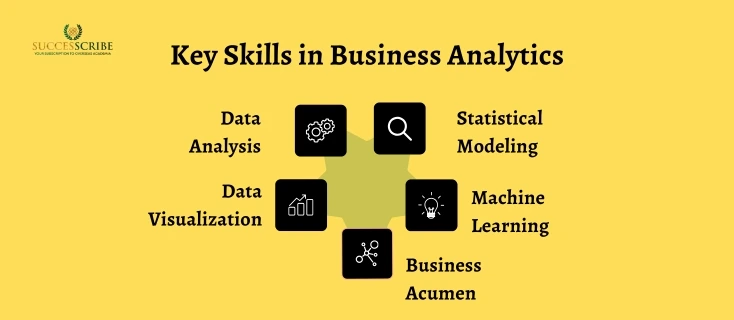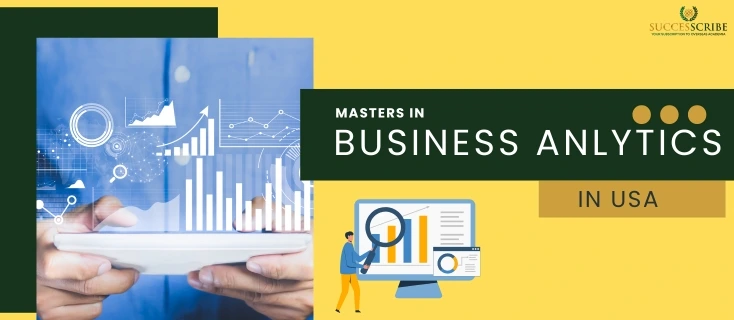Business Analytics is one of the top 10 fastest-growing careers in 2025, with a projected 23% job growth. The average salary for Business Analytics graduates in the USA exceeds $110,000, with top earners making over $150,000 annually. With industries like consulting, tech, finance, and healthcare seeking skilled analysts, pursuing Masters in Business Analytics in USA is your gateway to a high-paying, future-proof career. With the US hosting some of the best universities offering Master’s in Business Analytics programs, graduates can expect promising job prospects. In this topic, we will cover everything you need to know when planning to study Masters in Business Analytics in USA, from top universities to admission requirements, costs, and career prospects.
Why choose the USA for a Master’s in Business Analytics
Here are some of the reasons why someone should choose Masters in Business Analytics in USA:
- Business analytics professionals in the USA earn 2–3 times more than their counterparts in other countries. Graduates from U.S. universities are highly sought after, with starting salaries averaging 85,000 – 120,000
- MIT, Stanford, University of Chicago, and UT Austin rank among the top 10 globally for business analytics programs.
- Programs focus on AI, machine learning, and big data, ensuring graduates are industry-ready.
- Strong Industry Connection by which over 70% of students secure jobs through university career fairs and alumni networks.
- Over 1 million international students study in the USA, creating a diverse learning environment.
Admission Requirements for Master’s in Business Analytics in the USA
Here are the general criteria for Masters in Business Analytics in USA:
| Requirement | Details |
| Bachelor’s Degree | 4-year undergraduate degree (minimum GPA: 3.0 – 3.5/4.0) |
| Standardized Tests | GMAT: 600-700 (varies by university)GRE: 310-325 |
| English Proficiency | TOEFL: 90-100IELTS: 6.5 – 7.5 |
| Work Experience | 0-2 years (some universities prefer experience) |
| Letters of Recommendations (LORs) | 2-3 letters from professors or employers |
| Statement of Purpose (SOP) | Required, explaining career goals & motivation (500 – 1000 words) |
| Application Fee | $50 – $150 (varies by university) |
Top Universities offering Masters in Business Analytics in USA
Several universities in the USA offer esteemed Masters in Business Analytics programs that blend theoretical knowledge with practical application. Below is a table highlighting some of the top institutions, their program durations, and tuition fees:
| University Name | Tuition Fees (USD) | Average Salary After Graduation |
| MIT Sloan School of Management | $87,600 | $140,000+ |
| University of California, Los Angeles (UCLA) | $68,710 | $115,000+ |
| Purdue University | $56,700 | $95,000+ |
| Carnegie Mellon University | $72,000 | $120,000+ |
| Carnegie Mellon University (Tepper) | $72,000 | $120,000+ |
| University of Texas at Austin | $53,000 | $110,000+ |
| New York University | $78,000 | $125,000 |
| Columbia University | $80,000 | $130,000+ |
| University of Pennsylvania | $80,000 | $130,000+ |
| Michigan State University | $50,000 | $90,000+ |
| New York University (Stern) | $78,000 | $125,000+ |
| Northwestern University | $78,000 | $120,000+ |
| University of California, San Diego | $67,950 | $105,000+ |
| University of Notre Dame | $60,000 | $100,000+ |
Also Read: Best States in USA for International Students
Studying Costs for Masters in Business Analytics in USA
Studying for a Masters in Business Analytics in USA involves several costs, including tuition fees, living expenses, and other miscellaneous charges. While studying may be a bit expensive, the ROI is excellent, making it a worthwhile investment for your future.
| Expense | Cost (per year) |
| Tuition Fees (Public) | $40,000 – $60,000 |
| Tuition Fees (Private) | $60,000 – $80,000 |
| LivingExpense (Accommodation, Food, Transport)) | $18,000 – $38,000 |
| Medical Insurance | $1,500 – $3,000 |
| Study Material | $1,000 – $2,000 |
| Application Fees (per University) | $50 – $150 |
| Visa Fee | $185 |
Also Read: Bachelor Degree in USA for International Students
Scholarships
Many universities offer scholarships and financial aid to international students pursuing Masters in Business Analytics in USA. Some popular scholarships include:
- Fulbright Scholarship
- Chevening Scholarship
- University-Specific Scholarships: Many universities offer merit-based scholarships for MSBA students.
Overview of Business Analytics
Business Analytics involves the use of data, statistical analysis, and predictive modeling to make informed business decisions. It encompasses a range of techniques, including data mining, machine learning, and optimization, to analyze historical data and predict future trends.
Importance of Business Analytics
- Data-Driven Decision Making: Companies use analytics to make decisions based on data rather than intuition.
- Competitive Advantage: Businesses that leverage analytics effectively can outperform their competitors.
- Cost Reduction: Analytics can identify inefficiencies and reduce operational costs.
- Customer Insights: Understanding customer behavior through data can lead to improved customer satisfaction and retention.
Growth of the Business Analytics Industry
The global business analytics market was valued at $67.92 billion in 2020 and is expected to grow at a compound annual growth rate of 7.3% from 2021 to 2028. In the USA, the demand for business analytics professionals is projected to grow by 14% from 2020 to 2030, much faster than the average for all occupations.
Key Skills in Business Analytics

- Data Analysis: Proficiency in tools like Python, R, and SQL.
- Statistical Modeling: Understanding of regression analysis, hypothesis testing, and predictive modeling.
- Data Visualization: Ability to create compelling visualizations using tools like Tableau and Power BI.
- Machine Learning: Knowledge of algorithms and techniques for predictive analytics.
- Business Acumen: Understanding of business processes and the ability to translate data insights into actionable strategies.
Program Structure and Curriculum

In today’s data-driven world, businesses are heavily investing in analytics to make smarter, evidence-based decisions, increasing the demand for skilled professionals. If you’re considering a Masters in Business Analytics in USA, you are on the right path to securing a high-paying job in one of the most lucrative career domains of the future.
Here is the Program Structure and General Curriculum followed by most of the universities:
Duration and Format
Most Master’s in Business Analytics programs in the USA are designed to be completed in 10 to 18 months of full-time study. Some universities also offer part-time and online options to accommodate working professionals.
Core Courses
The curriculum typically includes a mix of core courses and electives. Core courses often cover the following topics:
- Data Management and Analytics
- Statistical Analysis and Predictive Modeling
- Business Intelligence and Data Visualization
- Optimization and Decision Analysis
- Business Strategies
- Machine Learning and Artificial Intelligence
Electives and Specializations
Students can often choose electives based on their career goals. Popular specializations include:
- Marketing Analytics
- Financial Analytics
- Healthcare Analytics
- Supply Chain Analytics
- Risk Management
Projects
Many programs require students to complete a capstone project, where they apply their skills to solve a real-world business problem. This project is often done in collaboration with industry partners, providing valuable hands-on experience.
Sample Curriculum for Business Analytics Program
| Semester | Course Title | Credits |
| 1 | Foundations of Business Analytics | 3 |
| 1 | Data Management and Analytics | 3 |
| 1 | Statistical Analysis | 3 |
| 2 | Machine Learning | 3 |
| 2 | Business Intelligence | 3 |
| 2 | Optimization | 3 |
| 3 | Projects | 3 |
| 3 | Elective (e.g., Marketing Analytics) | 3 |
Also Read: Animation Courses and Universities in USA
Jobs and Salary
Graduates of MSBA programs can pursue a variety of roles, including:
- Data Scientist
- Business Analyst
- Data Analyst
- Marketing Analyst
- Consultant
- Product Manager
Industries
Business analytics professionals are in demand across various industries, including:
- Consulting
- Technology
- Finance
- Healthcare
- Retail
Top Employers
Some of the top employers of MSBA graduates in the USA include:
- McKinsey & Company
- Bain & Company
- Microsoft
- Deloitte
- Amazon
- JPMorgan Chase
- IBM
- Apple
- Facebook (Meta)
- Walmart
Average Salaries for Business Analytics Roles
Here are some Job Roles and their average salary after Master in Business Analytics from the USA:
| Job Role | Average Salary |
| Business Analyst | $130,000 |
| Data Scientist | $120,000 |
| Data Analyst | $70,000 |
| Strategy Consultant | $110,000 |
| Operations Research Analyst | $85,000 |
| Marketing Analyst | $75,000 |
| Business Intelligence Analyst | $90,000 |
| Product Manager | $125,000 |
Key Drivers of the Business Analytics Boom in the USA

The field of Business Analytics is experiencing unprecedented growth in the United States, driven by the increasing reliance on data-driven decision-making across industries.
| Driver | Key Facts/ Statistics | Trend/Projection |
| Data Generation | 463 exabytes of data generated daily | 181 zettabytes by 2025 |
| Data-Driven Decision Making | 75% of enterprises operationalizing AI | BI market to reach $39.9 billion by 2027 |
| Advanced Technologies | AI market to reach $1.8 trillion by 2030 | 95% of customer interactions powered by AI |
| ROI for Businesses | 25% increase in productivity by 2025 | Global analytics market to hit $103.65B by 2026 |
| Demand for Skilled Professionals | Shortage of 250,000 data scientists by 2025 | Average Business Analyst salary: $130,000 |
| Indsutry Specific Applications | Healthcare analytics to reach $67.1B by 2026 | Retail analytics CAGR of 17.5% |
| Startups and Innovation | $100B VC funding for AI startups by 2025 | USA accounts for 50% of global analytics |
1. Explosion of Data Generation
The digital age has led to an exponential increase in data generation. According to Statista, the global volume of data created, captured, copied, and consumed is projected to grow to 181 zettabytes by 2025, up from 64.2 zettabytes in 2020. This data deluge has created a pressing need for professionals who can analyze and interpret this information to drive business strategies.
2. Increased Adoption of Advanced Technologies
The rise of advanced technologies such as Artificial Intelligence (AI), Machine Learning (ML), and Big Data Analytics has transformed how businesses operate. Companies are leveraging these technologies to gain insights, optimize operations, and predict future trends.
3. Demand for Data-Driven Decision-Making
Businesses are increasingly shifting from intuition-based decisions to data-driven strategies. This shift is fueled by the need for accuracy, efficiency, and competitive advantage. A Gartner report predicts that by 2025, 75% of enterprises will shift from piloting to operationalizing AI, driving a 5x increase in streaming data and analytics infrastructures.
4. High Return on Investment (ROI) for Businesses
Investing in business analytics has proven to deliver significant ROI for companies. By optimizing operations, reducing costs, and improving customer satisfaction, businesses can achieve substantial financial gains. Companies that adopt AI and analytics technologies are expected to see a 25% increase in productivity by 2025, according to McKinsey.
5. Growing Demand for Skilled Professionals
The demand for skilled business analytics professionals far exceeds the supply, creating a talent gap. This has led to increased enrollment in MSBA programs and higher salaries for graduates. By 2025, the USA will face a shortage of 250,000 data scientists and analysts, according to IBM.
6. Industry-Specific Applications
Business analytics is being adopted across diverse industries, including healthcare, finance, retail, and technology, driving its growth.
7. Rise of Startups and Innovation
The USA is home to a thriving ecosystem of startups and tech companies that are driving innovation in business analytics. Companies like Palantir, Tableau, and Snowflake have revolutionized the way businesses use data. The USA accounts for 50% of the global analytics market, with Silicon Valley being a major hub for innovation.
8. Global Competitiveness
As businesses compete on a global scale, the ability to harness data for strategic advantage has become a key differentiator. The USA, being a global leader in technology and innovation, is at the forefront of this trend. The USA ranks first in the Global Innovation Index 2025, driven by its strength in analytics and technology.
Return on Investment When Pursuing Masters in Business Analytics in USA
Pursuing an MSBA in the USA represents a significant financial investment. Tuition fees can range from $53,000 to $87,600, depending on the institution. However, the potential return on investment is substantial. Graduates often secure positions with competitive salaries, leading to a favorable return on their educational investment.
For example, graduates from MIT’s Sloan School of Management have reported average starting salaries of around $140,000 per year. Similarly, alumni from the University of Texas at Austin’s McCombs School of Business have seen strong employment outcomes, with many securing positions at leading companies.
Conclusion
As the demand for data-savvy professionals continues to rise, the importance of business analytics in shaping the future of business cannot be overstated. Whether you’re looking to advance your career or pivot to a new field, a Masters in Business Analytics in USA university can provide the skills and knowledge you need to succeed in this dynamic and ever-evolving industry.
Related Post
Cyber Security Courses and Universities in USA
Dental Hygienist Course and Universities in USA
Engineering Management Courses in USA
Duolingo Accepting Universities in USA











